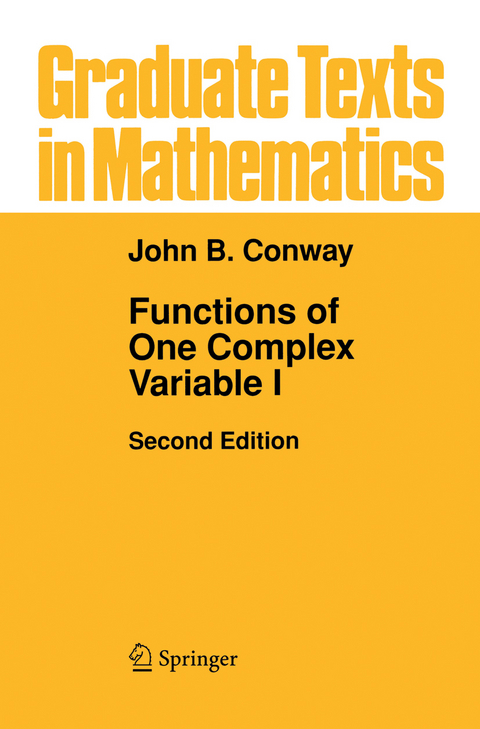
Functions of One Complex Variable I
Springer-Verlag New York Inc.
978-0-387-94234-6 (ISBN)
This book is intended as a textbook for a first course in the theory of functions of one complex variable for students who are mathematically mature enough to understand and execute E - 8 arguments. The actual pre requisites for reading this book are quite minimal; not much more than a stiff course in basic calculus and a few facts about partial derivatives. The topics from advanced calculus that are used (e.g., Leibniz's rule for differ entiating under the integral sign) are proved in detail. Complex Variables is a subject which has something for all mathematicians. In addition to having applications to other parts of analysis, it can rightly claim to be an ancestor of many areas of mathematics (e.g., homotopy theory, manifolds). This view of Complex Analysis as "An Introduction to Mathe matics" has influenced the writing and selection of subject matter for this book. The other guiding principle followed is that all definitions, theorems, etc.
I. The Complex Number System.- §1. The real numbers.- §2. The field of complex numbers.- §3. The complex plane.- §4. Polar representation and roots of complex numbers.- §5. Lines and half planes in the complex plane.- §6. The extended plane and its spherical representation.- II. Metric Spaces and the Topology of ?.- §1. Definition and examples of metric spaces.- §2. Connectedness.- §3. Sequences and completeness.- §4. Compactness.- §5. Continuity.- §6. Uniform convergence.- III. Elementary Properties and Examples of Analytic Functions.- §1. Power series.- §2. Analytic functions.- §3. Analytic functions as mapping, Möbius transformations.- IV. Complex Integration.- §1. Riemann-Stieltjes integrals.- §2. Power series representation of analytic functions.- §3. Zeros of an analytic function.- §4. The index of a closed curve.- §5. Cauchy’s Theorem and Integral Formula.- §6. The homotopic version of Cauchy’s Theorem and simple connectivity.- §7. Counting zeros; the Open Mapping Theorem.- §8. Goursat’s Theorem.- V. Singularities.- §1. Classification of singularities.- §2. Residues.- §3. The Argument Principle.- VI. The Maximum Modulus Theorem.- §1. The Maximum Principle.- §2. Schwarz’s Lemma.- §3. Convex functions and Hadamard’s Three Circles Theorem.- §4. Phragm>én-Lindel>üf Theorem.- VII. Compactness and Convergence in ihe Space of Analytic Functions.- §1. The space of continuous functions C(G, ?).- §2. Spaccs of analytic functions.- §3. Spaccs of meromorphic functions.- §4. The Riemann Mapping Theorem.- §5. Weierstrass Factorization Theorem.- §6. Factorization of the sine function.- $7. The gamma function.- §8. The Riemann zeta function.- VIII. Runge’s Theorem.- §1. Runge’s Theorem.- §2. Simple connectedness.- §3.Mittag-Leffler’s Theorem.- IX. Analytic Continuation and Riemann Surfaces.- §1. Schwarz Reflection Principle.- $2. Analytic Continuation Along A Path.- §3. Monodromy Theorem.- §4. Topological Spaces and Neighborhood Systems.- $5. The Sheaf of Germs of Analytic Functions on an Open Set.- $6. Analytic Manifolds.- §7. Covering spaccs.- X. Harmonic Functions.- §1. Basic Properties of harmonic functions.- §2. Harmonic functions on a disk.- §3. Subharmonic and superharmonic functions.- §4. The Dirichlet Problem.- §5. Green’s Functions.- XI. Entire Functions.- §1. Jensen’s Formula.- §2. The genus and order of an entire function.- §3. Hadamard Factorization Theorem.- XII. The Range of an Analytic Function.- §1. Bloch’s Theorem.- §2. The Little Picard Theorem.- §3. Schottky’s Theorem.- §4. The Great Picard Theorem.- Appendix A: Calculus for Complex Valued Functions on an Interval.- Appendix B: Suggestions for Further Study and Bibliographical Notes.- References.- List of Symbols.
"This book presents a basic introduction to complex analysis in both an interesting and a rigorous manner. It contains enough material for a full year's course, and the choice of material treated is reasonably standard and should be satisfactory for most first courses in complex analysis. The approach to each topic appears to be carefully thought out both as to mathematical treatment and pedagogical presentation, and the end result is a very satisfactory book for classroom use or self-study." --MathSciNet
| Reihe/Serie | Graduate Texts in Mathematics ; 11 |
|---|---|
| Zusatzinfo | XIV, 322 p. |
| Verlagsort | New York, NY |
| Sprache | englisch |
| Maße | 155 x 235 mm |
| Themenwelt | Mathematik / Informatik ► Mathematik ► Analysis |
| Mathematik / Informatik ► Mathematik ► Angewandte Mathematik | |
| Mathematik / Informatik ► Mathematik ► Finanz- / Wirtschaftsmathematik | |
| ISBN-10 | 0-387-94234-3 / 0387942343 |
| ISBN-13 | 978-0-387-94234-6 / 9780387942346 |
| Zustand | Neuware |
| Haben Sie eine Frage zum Produkt? |
aus dem Bereich


